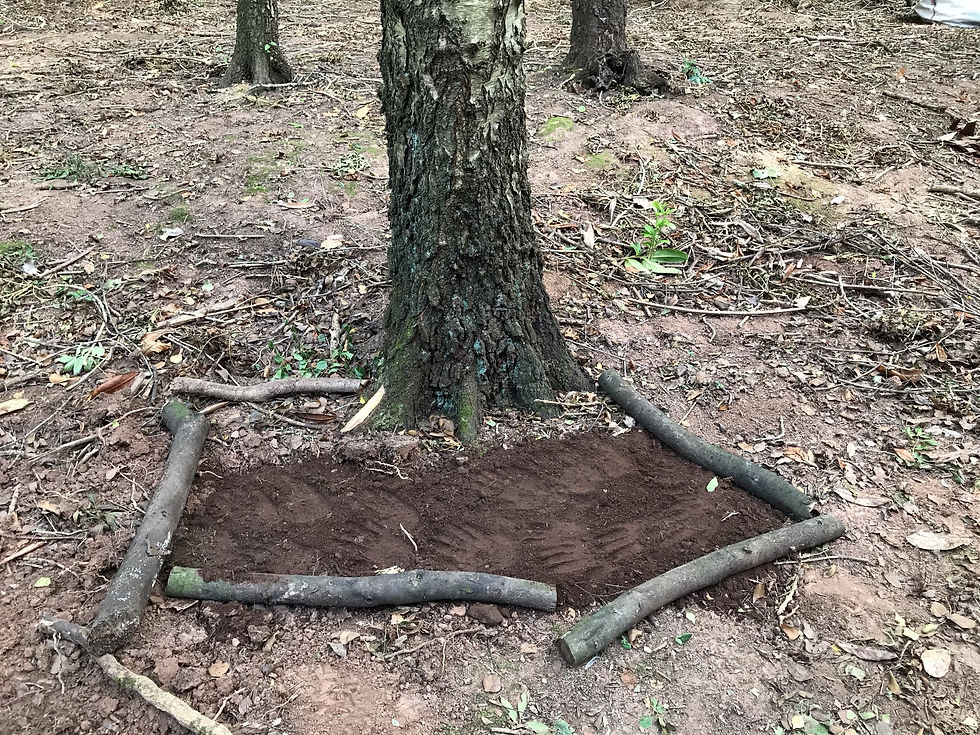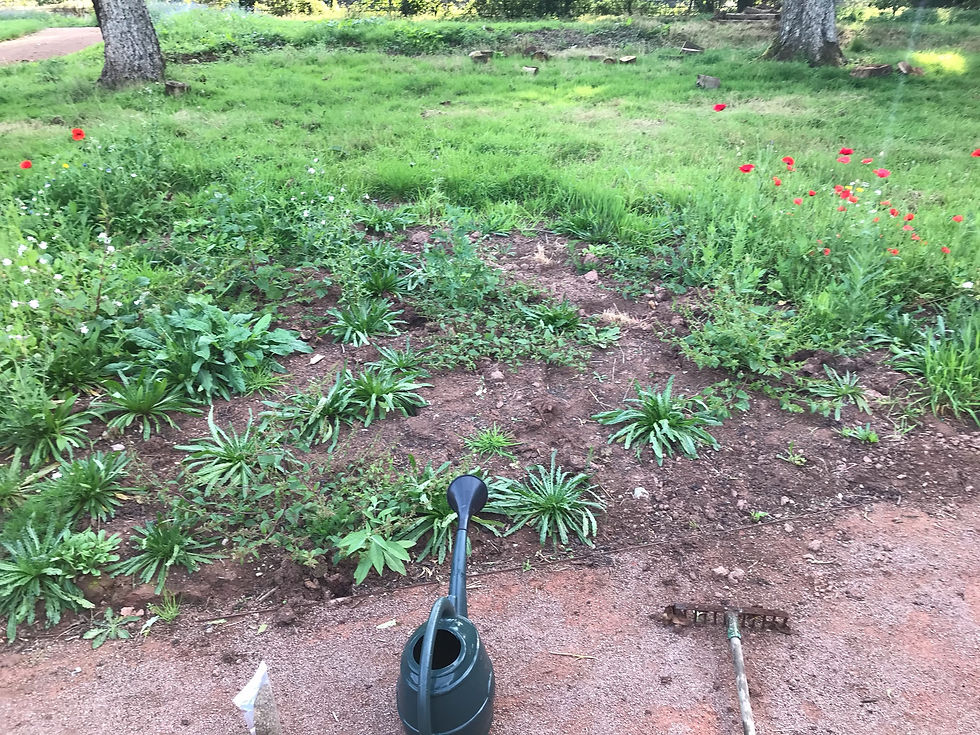
I was a very happy on my last trip back to take delivery of a 1000 strong regiment of English Bluebell bulbs. Last year's bluebell campaign involved our planting a modest couple of hundred bulbs and a small bag of seed. Sadly my planned trip at Easter back to the UK was cancelled because of the disruption to flights during lockdown. I was stuck indoors mostly in Dubai for 3 months and wasn't able to see any of the bluebells last year. Bluebell season on the Bromyard Downs comes a little later on our 200 m sandstone plateau at the very end of April and into May. I didn't make it back until mid June by which time the Bluebells had finished. Jane wrote about our first year's bluebell showing in a post called interlopers here and the problems with Spanish bluebells and hybrids.
As well as the huge bag of bluebells I purchased 100 Snakes Head Fritillary, Frittilaria meleagris for the meadow to join the remaining few that we have there but also 25o wild garlic or ransoms. The fritillaries were the first task. A foray online for information suggested that I should plant them at a depth of three times the height of the bulb with three to a hole. I decided to focus on the area near to the walnut trees as we knew that one bulb at least had survived from a small colony in the wheel rut of a bulldozer from the Spring's big garden works.

It was also a good opportunity to co-opt Jane's Sneeboer bulb planter. I have become slightly addicted to collecting these beautiful ash and stainless steel handmade tools - albeit vicariously by purchasing them as Christmas and birthday gifts.

I have a vision of filling the wall of the now cleared potting shed with rows and rows of beautifully oiled and sharpened handmade tools. There are worse things to collect.
I think technically these are corms and not bulbs but I may be wrong.

Three to a whole did not take too long. I am not even sure when they are supposed to flower - descriptions say March to May. I expect up on our sandstone bluff with the cooling Westerly winds they may make a late appearance like our bluebells seem destined to each year.

So hopefully we will have 30 or so small groupings of flowers to see in Spring in the meadow. I split up the holes into 3 or so groups in a chevron either side of the straight line of the mown path to the wood's entrance hall.

Nothing can prepare you for your first encounter with an Allium ursinum bulb. An alien squid straight out of a B movie. I have to say they pack a fragrant punch as well and teh bag had to be relocated from the utility room outside to the bench seat in the front porch. That woodland wild garlic smell is a joy but possibly not throughout the kitchen all day. These little fellows are fiddly in the extreme and faced with 250 of them I have to admit that I called time after about 150 and left the rest for Jane to do. A mistake as the ground is now far too dry to allow them to be planted. I did manage to insert a few small colonies around the drainage ditch and path entrance and main ride in the wood. Jane has ordered her own reinforcements and I assume if it rains then these can all go in. QWe may have help from a boy over half term if we are lucky as well. I know that Jane is sitting on 600 or so assorted other bulbs as well - but they only have to be planted once to get the ball rolling.

I think a trench technique I eventually adopted for the bluebells with a compost filler might have been a better strategy. Individual holes had to be carved out to suit the shape of each banana shallot like bulb. Each patch ended up looking like a grouping of ICBM silos.

I am hopeful that there will be a few nice patches to add to the two small existing colonies that appear to be growing wild in the wood come the Spring. Alliums are alos great for pollinators.

Next the main event - 1,000 bluebells. I was dreading having to dig 1000 holes and kept putting it off until the day of my departure was almost on me. In fairness I was both working from home and had been busy at times with visitors. Then a bright idea occurred to me. I am sure that it is not original. Rather than dig holes I dug a trench about 10 cm deep for each large grouping and threw in large handfuls of bulbs by the hundred. The only fiddly bit was making sure each bulb was the right way up so that the shoot would have a good start in life. We had a big pile of decent compost left so rather than backfill with the rock-hard clay I was able to give each bulb a much better start.

I just hope I can actually see them this year ! You can see in the picture below also the huge numbers of new Primroses and Foxgloves that have germinated in the newly lit soil this year. In many respects nature herself, given half a chance, is outpacing us with her own restoration work. It is humbling to create a small patch of light and to watch the whole system bounce back. I am kneeling here next to the first small area we cleared. A new understory is taking hold. What a sight that will be in 2021.

In the end I went with 3 large patches with 300 bulbs each for a grand show focusing the nice new areas of clearance at the front of the wood. I also reserved 100 bulbs to plant next to the great father Ash, Yggdrasil in the middle of the wood. Thats a special place with our tallest tree. Hopefully free - just - of Ash die back although some trees in the wood are obviously affected.

One day I hope the whole entrance hall to the wood will be a sea of Primroses and Foxgloves, Ramsoms and Bluebells. Where the light has reached the woodland floor again hundreds of new Primrose plants have germinated. The small carpet of green below is all new primrose plants. There are dozens of new patches like this. It should be a dazzling display of Primrose yellow and cobalt blue in time.

My final act on the morning of leaving was to sow 100 g of the "meadow maker" Yellow Rattle, Rhinathus Minor.

Yellow Rattle is parasitic on grasses so will weaken them and provide opportunities for other meadow species and flowers to take hold. The seed needs to be in firm contact with the soil to germinate so I got a rake and roughed up some pre-existing patches of bare earth and watered to get the seed to stick. I also developed a tactic of pressing seed into the exposed tops of molehills.

The seed needed to be sown at a density of 3 g per square metre so I could cover barely the size of a small badminton court. But again its a good start and each other yellow rattle plant should give rise to more self seeding. Over time we will beat back some of thr grasses and make more room for wild flowers.

I love the very satisfying cause and effect of sowing seed, Already Jane has managed to create a colony of Cornflowers and another quite diverse colony of several meadow varieties including Poppies and Corncockle. The whole edge of the main winding path is a sea of blue.

So that was my small Autumn woodland and meadow campaign. The vision is really to bring out the wood into the garden and to have the garden transition into the wood. It states the obvious but the honest and simple pleasure of seeing something like a patch of wild Primroses or native English Bluebells that you know you have taken action to restore is thoroughly good for the soul in a world where nature is in retreat everywhere. If we keep plugging away - literally in some instances when it comes to wild flowers then the garden should be a carpet of plants for pollinators. Primroses in particular will support emergent queen solitary bees at the beginning of Spring. The more pollinators and insects then the more bats and birds we can support in our small 5 acre haven. I am very excited about this particular direction of travel with the project. It is really only 18 months since we felled the first invasive Laurel on the edge of the wood and now we have a cleared area that feels like it is getting on for an acre. I should be posting up pictures of large swathes of new colour and life in about 6 or 7 months.
Comentarios